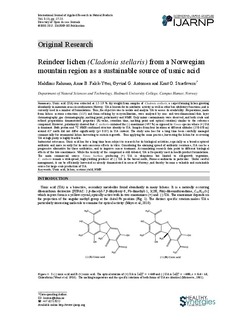Reindeer lichen (Cladonia stellaris) from a Norwegian mountain region as a sustainable source of usnic acid
Original version
Rahman, M., Falck-Ytter, A. B., Antonsen, Ø. G. & Strætkvern, K. O. (2015). Reindeer lichen (Cladonia stellaris) from a Norwegian mountain region as a sustainable source of usnic acid. International Journal of Applied Research in Natural Products, 8(3), 17-23. Lokalisert på http://www.ijarnp.org/index.php/ijarnp/article/view/302Abstract
Summary. Usnic acid (UA) was extracted at 1.5-1.9 % dry weight from samples of Cladonia stellaris, a carpet-forming lichen growing
abundantly in mountain areas in southeastern Norway. UA is known for its antibiotic activity as well as other bio-inhibitory functions, and is
currently used in a number of formulations. Thus, the objective was to isolate and analyze UA to assess its availability. Preparations, made
from lichen: acetone extraction (1:15) and from refining by recrystallization, were analyzed by one- and two-dimensional thin layer
chromatography, gas chromatography, melting point, polarimetry and NMR. Only minor contaminants were observed, and both crude and
refined preparations demonstrated properties (Rf-value, retention time, melting point and optical rotation) similar to the reference
compound. However, polarimetry showed that C. stellaris contained the (-) enantiomer (>97 %) as opposed to Usnea-species where (+) UA
is dominant. Both proton and 13C NMR confirmed structure identity to UA. Samples from four locations at different altitudes (250-650 m)
around 62o north did not differ significantly (p< 0.05) in UA content. The study area has for a long time been carefully managed
commercially for ornamental lichen harvesting to sustain regrowth. Thus applying the same practice, harvesting the lichen for recovering
UA at high purity is highly feasible.
Industrial relevance. Usnic acid has for a long time been subject to research for its biological activities, especially as a broad-sceptered
antibiotic and more recently for its anti-cancerous effects in vitro. Considering the alarming spread of antibiotic resistance, UA can be a
progressive alternative for those antibiotics, and to improve cancer treatment. Accumulating research data point to different biological
effects of the two enantiomers. While the toxicity of the compound is still debated, UA is frequently used in health product formulations.
The main commercial source Usnea barbata producing (+) UA is ubiquitous but limited to old-growth vegetation.
C. stellaris remain a widespread, high-yielding producer of (-) UA in the boreal north, Fenno-scandinavia in particular. Under careful
management, it can be efficiently harvested as already demonstrated in areas of Norway, and thereby become a valuable and sustainable
source for large-scale production of UA.
Description
This is an open access article. You can find it online by following this link: http://www.ijarnp.org/index.php/ijarnp/article/view/302
The article is published under a Creative Commons Attribution 3.0 Unported licens (CC BY 3.0) : http://creativecommons.org/licenses/by/3.0/

